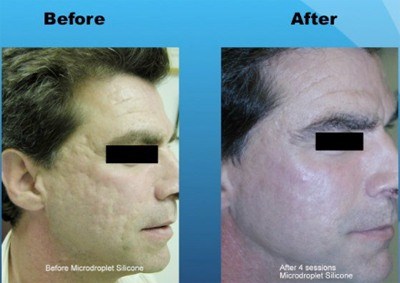Acne Scar Revision
Acne is one of the most common skin disorders experienced by up to 80% of people between 11 and 30 years of age. For most people, acne is a nuisance and leaves little in the way of lasting marks. Prevention of acne scarring is most often the key motivation behind treatment. For some unfortunate people, however, acne can leave both mental and physical scarring. Evaluating the face for the types of scars present will help determine the best treatment.
Acne scarring can be divided into 3 basic types: Boxcar, ice pick and rolling scars. Boxcar scars are shallow to deep, visually distinct depressions. They are usually 1-4 mm in diameter. Shallow boxcar scars can usually be treated by skin resurfacing techniques such as laser resurfacing. Wider and deeper scars are more effectively treated by punch elevation or excision.
Ice pick scars are narrow visually distinct tracts that descend vertically into the deeper layer surface skin. Because of their depth, resurfacing techniques cannot adequately treat these scars. Punch excision is the best therapy here with a single stitch closing the tiny hole.
Rolling scars are depressed scars of otherwise normal looking tissue. They are held down by fibers that tether the skin to underlying tissues, lighting tends to accentuate these scars, producing unwanted shadows. Because they are usually shallow, treatment of the overlying skin will not give good results. Silicone Microdroplet therapy is the most successful filler treatment for acne scars. It has been combined with subcision, and great results are seen. Subcision is the preferred technique to treat bound-down rolling scars, often followed by Silicone Microdroplet therapy and finished with fractional CO2 or Erbium:YAG laser resurfacing.
Subcision is a simple technique designed to free the tethering fibers from the overlying skin. A special needle with a cutting tip is used to slice these bands. Three tiny incision points are used to treat each site. These
incisions heal without visible mark. The doctor, with the patient guiding him, marks the areas to be treated. The areas to be released are then treated using a piston-like motion to cut the bands. It is like cutting the
ropes that hold a balloon to the earth. Upon completion of the treatment, the areas are dressed and bandaged. Bleeding is rare in most cases. Overabundant healing can occur and is easily treated. Bruising, if it occurs, usually fades within 1-2 weeks.
It is important to remember when undergoing any treatment for acne scars that improvement is the goal. Several treatments may be necessary to achieve optimal correction. Combining these different procedures may be needed to better address individual problems. Additional sessions to treat other areas or to retreat previously addressed areas can be scheduled at monthly intervals.

